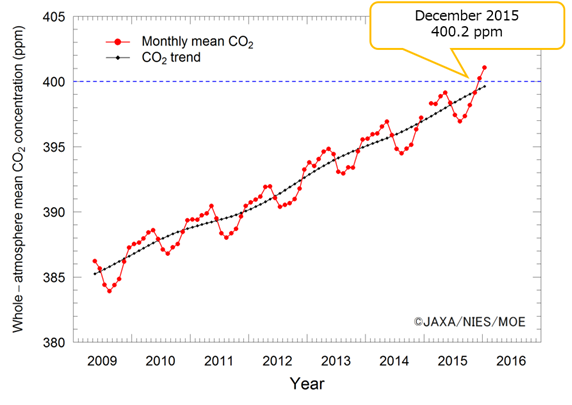Whole-atmospheric monthly CO2 concentration tops 400 ppm
- Preliminary GOSAT monitoring results -
Ministry of the Environment, Japan
National Institute for Environmental Studies
Japan Aerospace Exploration Agency
| The Ministry of the Environment, Japan (MOEJ), National Institute for Environmental Studies (NIES), and Japan Aerospace Exploration Agency (JAXA) have been monitoring carbon dioxide (CO2) and methane (CH4) by the Greenhouse gases Observing SATellite "IBUKI" (GOSAT). A recent provisional analysis of GOSAT observational data shows that the global atmospheric monthly mean CO2 concentration observed vertically through the whole atmosphere exceeded 400 ppm in December 2015 for the first time since GOSAT was launched in 2009. |
● Whole-atmospheric monthly mean CO2 concentrations as seen by GOSAT
The three parties - Ministry of the Environment, Japan (MOEJ), National Institute for Environmental Studies (NIES), and Japan Aerospace Exploration Agency (JAXA) - have published the whole-atmospheric monthly mean CO2 concentrations (observations made vertically through the whole atmosphere) analyzed and estimated from GOSAT observations from May 2009 to January 2016, and the trend line of the global CO2 mean (average seasonal cycle removed) on the website: NIES GOSAT Project "Whole-atmospheric monthly mean CO2 concentrations" (http://www.gosat.nies.go.jp/en/recent-global-co2.html).
According to a provisional analysis (until January 2016), the monthly mean concentration exceeded 400 ppm for the first time and it recorded 400.2 ppm in December 2015. It also recorded 401.1 ppm in January 2016, and it is observed that the concentration has increased in winter towards spring in the Northern Hemisphere (see the figure).
Several meteorological agencies such as the World Meteorological Organization (WMO) have already reported that the global monthly mean CO2 concentration based on data obtained at surface-level monitoring sites has exceeded 400 ppm. However, it is the first time that the whole-atmospheric CO2 mean exceeded 400 ppm monitored by GOSAT, which can observe CO2 concentrations from the surface to the top of the atmosphere (about 70km). It means that CO2 concentrations are increasing not only at the global surface but also in the global atmosphere.
The trend line of the global CO2 mean reached 399.6 ppm in January 2016, and if this increasing trend continues, it will probably be found upon more careful analysis that the trend line has exceeded 400 ppm around March 2016. It means that current global atmospheric CO2 concentrations substantially exceed 400 ppm.
These results are based on a preliminary analysis of the systematic bias of GOSAT. For more information about the analysis method and explanation, please see the below-mentioned website: "Whole-atmosphere monthly mean CO2 concentration" (http://www.gosat.nies.go.jp/en/recent-global-co2.html). An explanatory document (PDF) will be available soon on the website.

[Acknowledgement]
For the analysis of GOSAT observational data, two weather analysis datasets were used: GPV (Grid Point Value) data provided by the Japan Meteorological Agency and JCDAS data generated in the JRA-25 long-term reanalysis project by the Japan Meteorological Agency and the Central Research Institute of Electric Power Industry.
[Contact Information]
About GOSAT data and analysis results:
NIES Satellite Observation Center, GOSAT Project
Phone: +81-29-850-2966
About GOSAT, onboard sensors, and observation status:
Masakatsu Nakajima
JAXA Space Technology Directorate I
GOSAT-2 Project Team
Phone: +81-50-3362-6130
- What's New
- What's New 2025
- What's New 2024
- What's New 2023
- What's New 2022
- What's New 2021
- What's New 2020
- What's New 2019
- What's New 2018
- What's New 2017
- What's New 2016
- What's New 2015
- What's New 2014
- What's New 2013
- What's New 2012
- What's New 2011
- What's New 2010
- What's New 2009
- What's New 2008
- What's New 2007
- What's New 2006
- What's New 2005
- What's New 2004
- What's New 2003
- What's New 2002
- Event Information
- Visit NIES